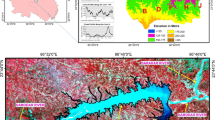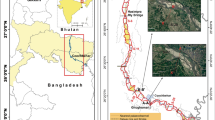Abstract
Avulsion is a natural fluvial process but considered it as a hazard in the populated region due to the chance of immense failure of lives and properties. So, early warning indicates that the zone of avulsion can facilitate the people living there. About 317 numbers of local and regional historical imprints of channel cutoff along river Kulik claim the need of this work. The present study tried to identify avulsion potential zone (APZ) of Kulik river of Indo-Bangladesh using multi-parametric weighted combination approach. Analytic hierarchy approach (AHP) is applied for weighting the used parameters. Avulsion potential model clearly exhibits that 9.51-km stream segment of middle and lower catchment is highly susceptible for avulsion especially during sudden high discharge and earthquake incidents. There is also high chance of channel avulsion following the existing Paleo-avulsion courses and left channels. Hard points can also be erected alongside the main channel for resisting channel avulsion propensity.






Similar content being viewed by others
References
Abbe, T. B., & Montgomery, D. R. (1996). Large woody debris jams, channel hydraulics and habitat formationin large rivers. Regulated Rivers Research & Management, 12, 201–221.
Asproth, V., Holmberg, S.C., & Hakansson, A. (1999). Decision support for spatial planning and management of human settlements.In: International Institute for Advanced Studies in systems research and cybernetics. In: Lasker, G.E. (Ed.), advances in support systems research, Windsor, Ont., Canada, 5, 30–39.
Chakraborty, A. (2017). Impact of changing river course on livelihood adjustment of the riverine island dwellers in the downstream of Farakka barrage, India, Ph.D. thesis submitted tothe University of Gour Banga, Malda, West Bengal, India, 1–189.
Chakraborty, T., & Ghosh, P. (2009). The geomorphology and sedimentology of the Tista megafan, Darjeeling Himalaya: Implications for megafan building process. Geomorphology. https://doi.org/10.1016/j.geomorph.2009.06.035.
Chakraborty, T., Kar, R., Ghosh, P., & Basu, S. (2010). Kosi megafan: Historical records, geomorphology and the recent avulsion of the Kosi River. Quaternary International, 227(2), 143–160. https://doi.org/10.1016/j.quaint.2009.12.002.
Chatanantavet, P., & Lamb, P. M. (2014). Sediment transport and topographic evolution of a coupled river and river plume system: An experimental and numerical study. Journal of Geophysical Research - Earth Surface, 119, 1263–1282. https://doi.org/10.1002/2013JF002810.
Chen, Y., Overeem, I., Kettner, J. A., Gao, S., & Syvitski, M. P. J. (2015). Modeling flood dynamics along the superelevated channel belt of the Yellow River over the last 3000 years. Journal of Geophysical Research - Earth Surface, 120(7), 1321–1351. https://doi.org/10.1002/2015jF003556.
Collins, B. D., & Montgomery, D. R. (2011). The legacy of Pleistocene glaciations and the organization of lowland alluvial process domains in the Puget sound region. Geomorphology, 126, 174–185.
Collins, B. D., Montgomery, D. R., Fetherston, K. L., & Abbe, T. B. (2012). The floodplain large-wood cycle hypothesis: A mechanism for the physical and biotic structuring of temperate forested alluvial valleys in the North Pacific coastal ecoregion. Geomorphology, 139-140, 460–470. https://doi.org/10.1016/j.geomorph.2011.11.011.
Constantine, J. A., McLean, S. R., & Dunne, T. (2009). A mechanism of chute cutoff along large meandering rivers with uniform floodplain topography. Geological Society of America Bulletin, 122, 855–869.
Das, R. T. (2016). Assessment of channel Bank susceptibility and Bank stability of a braided reach of river ganga near Panchanandapur, Malda. Int. Res. Journal of Earth Science, 4(3), 11–23.
Das, S. (2017). Changing hydro-geomorphological characteristics of Kalindri river, Malda district and their impacts on riparian livelihood: A geographical review. Ph.D. thesis submitted to the University of Gour Banga (pp. 34–112). India: Malda.
Das, S., & Pal, S. (2016). Character and cardinality of channel migration of Kalindri River, West Bengal, India. International Research Journal of Earth Sciences, 4(1), 13–26.
Eastman, J.R. (1997). Idrisi for windows, version 2.0: Tutorial exercises, graduate School of Geography—Clark University, Worcester, MA.
Edmonds, D. A., Hajek, E. A., Downton, N., & Bryk, A. B. (2016). Avulsion flow-path selection on rivers in foreland basins. Geological Society of America, 44, 695–698. https://doi.org/10.1130/G38082.1.
Fisk, H.N. (1944). Geological investigation of the alluvial valley of the lower Mississippi River. U.S. Army Corps Eng., Mississippi River Comm. Rep., Vicksburg, Mississippi.
Ganti, V., Chu, Z., Lamb, M. P., Nittrouer, J. A., & Parker, G. (2014). Testing morphodynamic controls on the location and frequency of river avulsions on fans versus deltas: Huanghe (Yellow River), China. Geophysical Research Letters, 41, 7882–7890. https://doi.org/10.1002/2014GL061918.
Gilvear, D. J., & Harrison, D. J. (1991). Channel change and the significance of floodplain stratigraphy: 1990 flood event lower river Tay, Scotland. Earth Surface Processes and Landforms, 16(8), 753–761.
Hajek, E., & Wolinsky, M. A. (2012). Simplified process modeling of river avulsions and alluvial architecture: Connecting models and field data. Sedimentary Geology, 257–260, 1–30. https://doi.org/10.1016/j.sedgeo.2011.09.005.
Hajek, E. A., Heller, P. L., & Schur, E. L. (2012). Field test of autogenic control on alluvial stratigraphy (Ferris formation, upper cretaceous-Paleogene, Wyoming). Geological Society of America Bulletin, 124(11–12), 1898–1912.
Hajek, E. A., & Edmonds, D. A. (2014). Is river avulsion style controlled by floodplain mrphodynamics? Geology, 42, 199–202. https://doi.org/10.1130/G35045.1.
Heller, P. L., & Paola, C. (1996). Downstream changes in alluvial architecture: An exploration of controls on channel-stacking patterns. Journal of Sedimentary Research, 66(2), 297–306.
Imran, J., Parker, G., & Katopodes, N. (1998). A numerical model of channel inception on submarine fans. Journal of Geophysical Research, 103, 1219–1238.
Karssenberg, D., & Bridge, J. S. (2008). A three-dimensional numerical model of sediment transport, erosion and deposition within a network of channel belts, floodplain and hill slope: Extrinsic and intrinsic controls on floodplain dynamics and alluvial architecture. Sedimentology, 55, 1717–1745.
Khatun, S., & Pal, S. (2016). Identification of prospective surface water available zones with multi criteria decision approach in Kushkarani River basin of eastern India. Archives of Current Research International, 4(4), 1–20. https://doi.org/10.9734/ACRI/2016/27651.
Korup, O. (2004). Landslide-induced river channel avulsions in mountain catchments of Southwest New Zealand. Geomorphology, 63, 57–80. https://doi.org/10.1016/j.geomorph.2004.03.005.
Larkin, Z. T., Tooth, S., Ralph, T. J., Duller, G. A. T., McCarthy, T., Keen-Zebert, K. A., & Humphries, M. (2017). Timescales, mechanisms, and controls of incisional avulsions in floodplain wetlands: Insights from the Tshwane River, semiarid South Africa. Geomorphology, 283, 158–172. https://doi.org/10.1016/j.geomorph.2017.01.021.
Leeder M.R. (1977). A quantitative stratigraphic model for alluvium with special reference to channel deposit density and interconnectedness. In Fluvial Sedimentology. A.D. (ed.) Miall, 5, 587–96. Calgary: Can. Soc. Petrol. Geol.
Leopold, L.B., Wolman, M.G., & Miller, J.P. (1995). Fluvial processes in geomorphology. Courier Dover Publications.
Macklin, M.G., Lewin, J. (2015). The rivers of civilization. Quaternary Science Reviews 114. https://doi.org/10.1016/j.quascirev.2015.02.004
Makaske, B., Smith, D. G., & Berendsen, H. J. (2002). Avulsions, channel evolution and floodplain sedimentation rates of the anastomosing upper Columbia River, British Columbia, Canada. Sedimentology, 49, 1049–1071.
Morón, S., Amos, K., Edmonds, D. A., Payenberg, T., Sun, X., & Thyer, M. (2017). Avulsion triggering by El Niño–southern oscillation and tectonic forcing: The case of the tropical Magdalena River, Colombia. Ecological Society of American Bulletin, 129, 1300–1313. https://doi.org/10.1130/B31580.1.
Morozova, G. S., & Smith, N. D. (2000). Holocene avulsion styles and sedimentation patterns of the Saskatchewan River, Cumberland marshes, Canada. Sedimentary Geology, 130, 81–105.
Mukherjee, K., & Pal, S. (2017). Channel migration zone mapping of the river ganga in the Diara surrounding region of eastern India. Environment, Development and Sustainability. https://doi.org/10.1007/s10668-017-9984-y.
Mukhopadhyay, S., & Das, P. (2013). Channel deranging and its impacts: A study on Mayurakshi-Kuya interflive, Santan Pargana and Birbhum districts, Jharkhand and West Bengal, Ind. Indian Journal of Geomorphology, 2, 37–45.
Nanson, G. C., & Knighton, A. D. (1996). Anabranching rivers: Their cause, character classification. Earth Surface Processes Landforms, 21, 217–239.
Parker, C., Clifford, N. J., & Thorne, C. R. (2012). Automatic delineation of functional river reach boundaries for river research and applications. River Research and Application, 28(10), 1708–1725.
Phillips, J. D. (2009). Avulsion regimes in southeast Texas rivers. Earth Surface Processes Landforms, 34, 75–87. https://doi.org/10.1002/esp.
Ralph, T. J., Hesse, P., & Kobayashi, T. (2016). Wandering wetlands: Spatial patterns of historical channel and floodplain change in the Ramsar-listed Macquarie marshes, Australia. Marine and Freshwater Research, 67, 782–802. https://doi.org/10.1071/MF14251.
Rashid, B., Islam, S. U., & Islam, B. (2015). Sub-surface geology and evolution of the Barind tract, Bangladesh. American Journal of Earth Science, 2(2), 22–38 (http://www.openscienceonline.com/journal/ajes).
Rasyid, A., Akbar, A. S., Nurdin, M., Jaya, N., Ibrahim, I. (2016). Impact of human interventions on mangrove ecosystem in spatial perspective. IOP Conf. Series: Earth and Environmental Science 47. https://doi.org/10.1088/1755-1315/47/1/012041
Rudra, K. (2010). Dynamics of the ganga in West Bengal (1764–2007): Implications for science policy interaction. Quaternary International, 227(2), 161–169. https://doi.org/10.1016/j.quaint.2009.10.043.
Saaty, T. L. (1980). The analytic hierarchy process. New York, NY: McGraw-Hill.
Saaty, T. L. (2004). Fundamentals of the analytic network process – Multiple networks with benefits, costs, opportunities and risks. Journal of Systems Science and Systems Engineering, 13(3), 348–379.
Sinha, R. (2009). The great avulsion of Kosi on 18 august 2008. Current Science, 97(3), 429–433.
Sinha, R., Bapalu, G., Singh, L., Rath, B. (2008). Flood risk analysis in the Kosi River basin, north Bihar using multi-parametric approach of analytical hierarchy process (AHP). Journal of the Indian Society of Remote Sensing, 36(4), 335–349
Sinha, R., Gaurav, K., Chandra, S., & Tandon, S. K. (2013). Exploring the channel connectivity structure of the august 2008 avulsion belt of the Kosi River: Application to flood risk assessment. Geology, 41, 1099–1102.
Sinha, R., Sripriyanka, K., Jain, V., & Mukul, M. (2014). Avulsion threshold and planform dynamics of the Kosi River in North Bihar (India) and Nepal: A GIS framework. Geomorphology, 216(2014), 157–170. https://doi.org/10.1016/j.geomorph.2014.03.035.
Slingerland, R., & Smith, N. D. (2004). River avulsions and their deposits. Annual Review of Earth and Planetary Sciences, 32, 257–285.
Slingerland, R., & Smith, N. D. (1998). Necessary conditions for a meandering-river avulsion. Geology, 26, 435–438.
Stouthamer, E., & Berendsen, H. J. A. (2001). Avulsion frequency, avulsion duration, and interavulsion period of Holocene channel belts in the rhine-meuse delta, the Netherlands. Journal of Sedimentary Research, 71(4), 589–598. https://doi.org/10.1306/11210071058.
Thakur, P. K., Laha, C., & Aggarwal, S. P. (2012). River bank erosion hazard study of river ganga, upstream of Farakka barrage using remote sensing and GIS. Natural Hazards, 61, 967–987. https://doi.org/10.1007/s11069-011-9944-z.
Tooth, S., Rodnight, H., Duller, G. A. T., McCarthy, T. S., Marren, P. M., & Brandt, D. (2007). Chronology and controls of avulsion along a mixed bedrock-alluvial river. Geological Society of America Bulletin, 119, 452–461. https://doi.org/10.1130/B26032.1.
Author information
Authors and Affiliations
Corresponding author
Rights and permissions
About this article
Cite this article
Sarkar, D., Pal, S. Construction of avulsion potential zone model for Kulik River of Barind Tract, India and Bangladesh. Environ Monit Assess 190, 301 (2018). https://doi.org/10.1007/s10661-018-6662-y
Received:
Accepted:
Published:
DOI: https://doi.org/10.1007/s10661-018-6662-y




